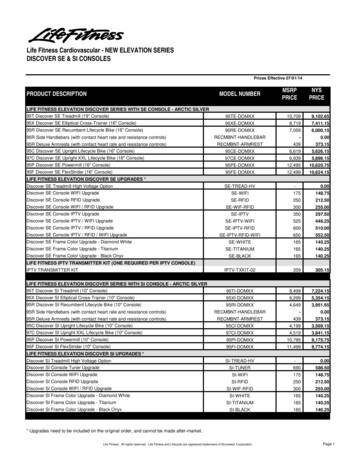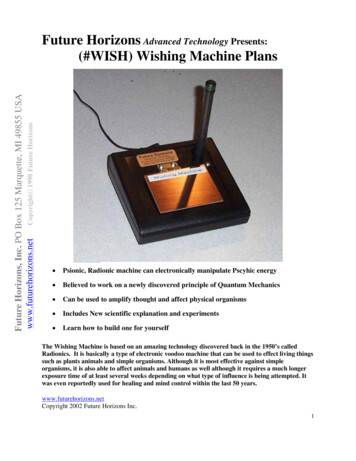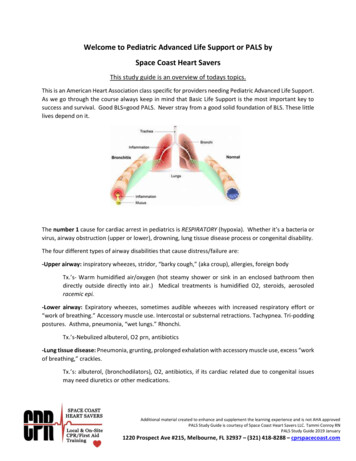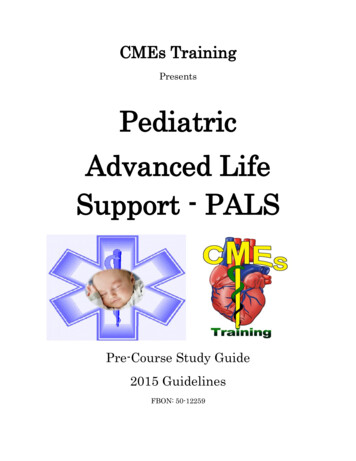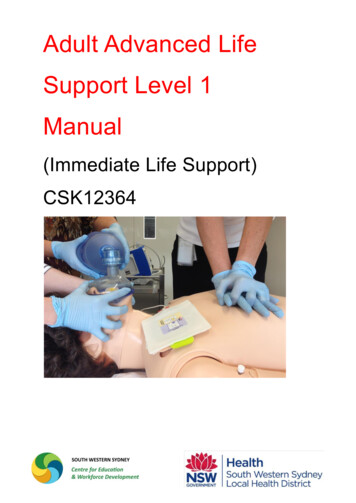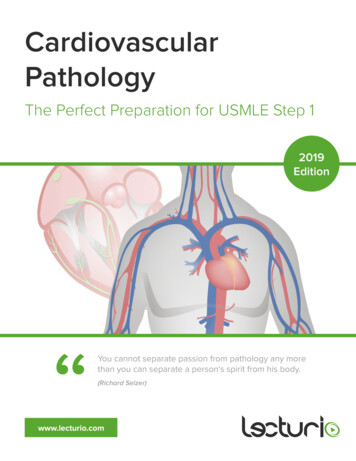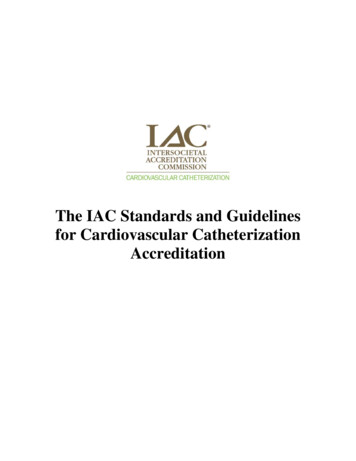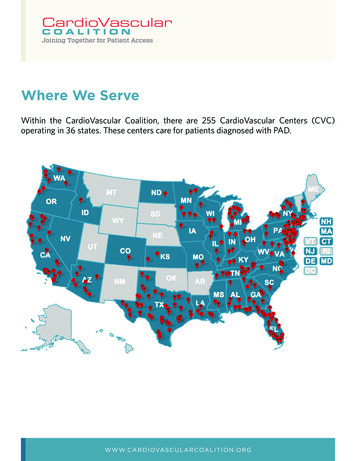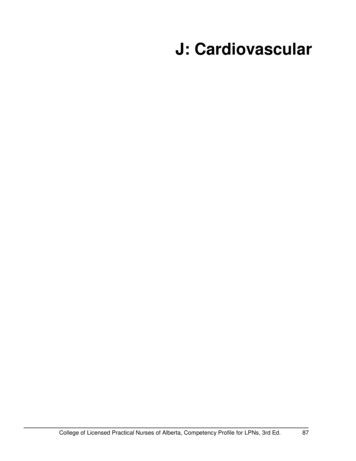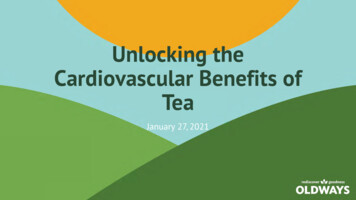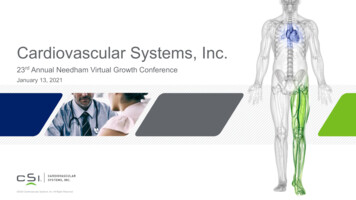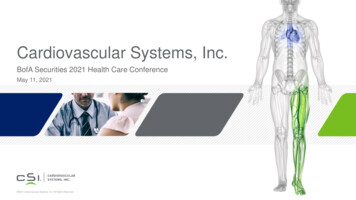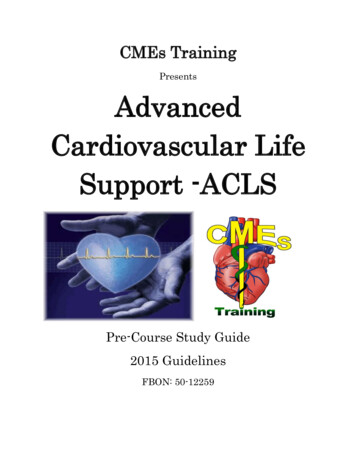
Transcription
CMEs TrainingPresentsAdvancedCardiovascular LifeSupport -ACLSPre-Course Study Guide2015 GuidelinesFBON: 50-12259
CMEs TrainingTable of contents:Content:Page:Welcome pages3-4General information5Sample Agenda6What is ACLS7- 9Patient assessment10Airway skills11-13Electrical therapy14Vascular access15-19ACLS medications20-24ACLS scenarios25-31Acute coronary syndromes (ACS)32-33Stroke34-35ECG review36-44ACLS algorithms45-48ACLS math49-54CMEs Training 11369 Okeechobee Blv. Ste. 300, Royal Palm Beach Fl. 33411 877-850-2702 Page 2
CMEs TrainingThis packet is intended for use as a supplement PRIOR to attending an AdvancedCardiac Life Support Course.Welcome to CMEs Training pre-course study packet. Critical Medical Education &Training, Inc., (CMEs Training), is committed to improving the quality ofhealthcare by providing new skills and knowledge as it becomes available throughcontinuing education. Whatever your goal – whether it be career enhancement,personal or re-licensure, CMEs Training will provide continuing education to thedisciplines it supports through Professionalism, Respect, Integrity, Dependabilityand Evaluation, (PRIDE).CMEs Training recognizes that balancing home and career can be difficult so wehave developed learning opportunities that are flexible and present themselves notonly in the traditional classroom setting but as a convenient alternative, via on-lineprograms. Additionally, we can customize any curriculum to fit the needs of yourcompany and bring it to you!Critical Medical Education & Training Incorporated is a state-of-the-art educationaland training institution committed to providing the highest level of instructionavailable for a wide variety of medical disciplines. CMEs Training offers on-lineclasses and satellite facilities in the following cities: Tampa, Jacksonville, Orlandoand Gainesville with additional sites being added within the near future. Inaddition to the above facilities CMEs Training will provide instruction at medicalinstitutions, fire training facilities and private businesses.CMEs Training is approved by the American Heart Association, Florida Board ofNursing and Florida Department of Emergency Medicine to offer a wide variety ofcourses to fit almost any medical educational need.CMEs Training 11369 Okeechobee Blv. Ste. 300, Royal Palm Beach Fl. 33411 877-850-2702 Page 3
CMEs Training instructors come to us with very diversified backgrounds within themedical and fire rescue community and have extensive experience educatingmedical professionals from a variety of disciplines. All are fully licensed andAmerican Heart Association compliant, have attained a high level of respectprofessionally, many with twenty to over thirty years of experience in theirrespective disciplines and have received professional recognition and awards priorto becoming instructors at CMEs Training.The AHA has set the GOLD STANDARDS FOR RESUSCITATION GUIDELINESAND continues to lead the field in Emergency Cardiac RESUSCITATION for allmedical professionals.The AHA recognizes only those institutions that can provide the required initial andrecertification courses as mandated by the AHA.CMEs Training provides these Gold Standards of Resuscitation guideline courses ina format that is stress-free, flexible to the needs of the student and with the latestpower point and visual teaching aids. CEUs are no longer available forrecertification of BLS, ACLS or PALS.Thank you for choosing CMEs Training for your educational needs. NOW LET’SGET STARTED!CMEs Training 11369 Okeechobee Blv. Ste. 300, Royal Palm Beach Fl. 33411 877-850-2702 Page 4
CMEs TrainingACLS Study GuideRead Pre Course Study MaterialGuidelines have recently changed and certain American Heart Association (AHA)textbooks, materials and handbooks are available now at our bookstore. Please check withyour educator to library AHA textbooks or order materials by calling Channing Bete at 800611-6083 or visit channingbete.com or Laerdal Medical at 877-523-7325 orwww.laerdal.comTHE PRE-COURSE EXAM IS NOW LOCATED ON-LINE ATwww.heart.org/eccstudentENTER CODE: acls15(WATCH THE NEW VIDEOS, YOU MUST SCORE 80%)At the end of this course you must be able to demonstrate treatment of the followingobjectives during a simulated VF (Ventricular Fibrillation), VT (Ventricular Tachycardia)and PEA (Pulseless Electrical Activity) cardiac arrest scenario: Assessing a victim by the primary CAB and secondary ABCD’sEffective adult 1 and 2 rescuer CPRUsing an AED on an adultSafe defibrillation with a manual defibrillatorMaintaining an open basic airway (BLS)Confirmation of effective ventilationAddressing vascular access (IV and IO)Stating rhythms, appropriate drug, route and doseConsideration of treatable causes of PEA arrestWhat happens if I do not do well in this course?The Course Director or Lead Instructor will “remediate” (tutor) you and upon remediationyou will be permitted to continue with the course.Any questions please contact our office at:877-850-2702 or 954-318-6080 or online at www.cmestraining.comCMEs Training 11369 Okeechobee Blv. Ste. 300, Royal Palm Beach Fl. 33411 877-850-2702 Page 5
ACLS Sample Initial Course AgendaApproximately 13-16 hoursDay 1: Registration Welcome; introduction Video introduction:o ACLS Course overview/ science updateo BLS Primary survey and secondary survey Dynamic lecture on science, technology and AHA standards Practical sessionso Respiratoryo BLS Lunch Practical sessionso VF/Pulseless VTo Vascular accesso Bradycardiao TachycardiaDay 2: Q&ALesson on ACSLesson on StrokePractical stationo Putting it all togethero Mega-code practiceLunchMega code evaluations (testing)Written evaluations (testing)Course evaluation/remediationDistribution of cardsCMEs Training 11369 Okeechobee Blv. Ste. 300, Royal Palm Beach Fl. 33411 877-850-2702 Page 6
CMEs TrainingWhat is ACLS?ACLS is an “assess-then manage” approach for those at risk of or in cardiac arrest.This approach is outlined in algorithms within your pre-course materials. Instructorto assess learning needs of students.Primary CAB and Secondary ABCD’sThis is a methodical “assess-then-manage” approach used to treat adults inrespiratory distress and failure, stable and unstable arrhythmias and pulselesscardiac arrest.Algorithms are “menus” that guide you through recommended treatmentinterventions.Know the following: ABCD’s approach is in all ACLS case scenarios. Thisinformation is gathered during the assessment and will determine which algorithmyou choose for the patient treatment.Primary CAB and Secondary ABCD’s refer to unconscious pulseless patients andthe use of an AED/Monitor Defibrillator:Assess patient/victim: Tap and ask “Are you OK?”For the adult patient:o Send someone to call 911 and bring the AEDo If alone call 911, get an AED and return to the victimCMEs Training 11369 Okeechobee Blv. Ste. 300, Royal Palm Beach Fl. 33411 877-850-2702 Page 7
C – Chest compressions/Circulation Check a pulsePatientRateRatioAdult100 compressionsper minute100 compressionsper minute30:2ChildInfantAt least 100compressions perminute30:2 for onerescuer (5cycles) and 15:2two rescuer (10cycles)30:2 for onerescuer (5cycles) and 15:2for two rescuer(10 cycles)Depth ofCompression2 inches or 5 cm2 inches/ 5 cm or1/3 thecircumference ofthe chest1.5 inches/ 4 cmor 1/3 thecircumference ofthe chestA – Airway: Basic Life Support Airway: Head-tilt/Chin lift, use of adjunctiveequipment or manual jaw thrust.B – Breathing: Assess for adequate breathing:If adequate: provide 2 breaths over 1 second eachEach breath should cause a visible chest rise and fallUse mouth-to-mouth or barrier device, bag-valve-mask ventilation with 2person CPR only.Provide 5 cycles of CPR (about 2 minutes)2-rescuers: the compressor must pause while the 2 breaths are givenChange compressors after 5 cycles to avoid fatigue and ineffectivenessD – Defibrillation: When an AED arrives, immediately power on unit:Follow the voice prompts: **Use adult pads on adults or on the pediatricpatient but only use pediatric pads for pediatric patients.**For pediatric patients defibrillation will be delivered @ 2j/kg followed by 4j/kgwith a maximum of 10j/kg**For pediatric patients pads may be placed anterior/posteriorCMEs Training 11369 Okeechobee Blv. Ste. 300, Royal Palm Beach Fl. 33411 877-850-2702 Page 8
CMEs TrainingACLS Assessment/ Secondary ABCD’s:Airway: Head Tilt / Chin Lift Use Bag mask with 2 person CPRProvide each breath over 1 second eachCompressor pauses to allow the 2 breathsConsider inserting an advanced airway (see advanced airway page)Breathing: Look for visible chest rise during each breathConfirm advanced airway tube placement (see advanced airway page)Secure the airway tubeCompressor now gives 100 continuous compressions per minuteVentilator gives 8-10 breaths per minute (one every 6-8 seconds)AdultPediatricInfantBLS Airway1 breath every 5-6 1 breath every 3- 1 breath every 3seconds5 seconds5 secondsALS Airway in place1 breath every 6-8 1 breath every 3- 1 breath every 3seconds max 8-10 5 seconds5 secondsbreaths/min Circulation: Obtain vascular access with an IV (Intravenous) or IO (Intraosseous)Cannulation Give medication as recommended per algorithmDifferential Diagnosis: “Why is this patient in this rhythm?” Look for possiblecauses:6 H’s6 aHydrogen Ion (acidosis)TamponadeTension PneumothoraxToxins-poisons, drugsThrombosis-coronary (AMI) –Pulmonary(PE)CMEs Training 11369 Okeechobee Blv. Ste. 300, Royal Palm Beach Fl. 33411 877-850-2702 Page 9
CMEs TrainingMedical Patient Assessment1. Scene size up/ scene safety (AHA BLS Guidelines) 5 questions to ask:a. Do I have my BSI?b. Is the scene safe?c. Nature of incident?d. Number of patients?e. Are additional resources needed?2. General Assessmenta. Identify immediate threatsb. Identify chief complaintsc. Position patient for assessment3. Initial assessment (if not in cardiac arrest)a. Airway (BLS Airway: Head-tilt/chin lift)b. Breathing (Y/N) Rate, quality, tidal volumei. Rate 8 assist with BVMc. Circulationi. Radial pulse, carotid pulse, skin color, temperature, capillaryresponsed. Disabilitiesi. AVPUe. Establish priorityi. Is the patient STABLE vs. UNSTABLE?ii. Stable no serious signs or symptoms v/s stableiii. Unstable hemodynamic status, B/P low, chest pain, severeSOB, decreased LOC4. Focused History/Physical Exama. Responsive patienti. Hx, cc, OPQRST, SAMPLERb. Focused medical assessmenti. Chief complaintii. Vital signsc. Unresponsive patienti. Rapid head to toe (correct all life threatening conditions)5. On-going assessmentsa. Vital signs for unstable patients every 5 minutesb. Vital signs for stable patients every 15 minutesCMEs Training 11369 Okeechobee Blv. Ste. 300, Royal Palm Beach Fl. 33411 877-850-2702Page 10
CMEs TrainingAirway SkillsDuring this course you will be expected to participate in manikin practice anddemonstrate proficiency in the below skills:Basic Airway: (BLS)Oxygen: To use or not to use Open the airwayo Use the head tilt – chin lift when assessing for adequate breathingo Use a jaw thrust for unresponsive, trauma or drowningo If unable to open the airway with a jaw thrust, use head tilt – chin lift Maintain the airwayo Insert an oropharyngeal airway when unconscious with no cough orgag reflexo Insert a nasopharyngeal airway when a cough or gag reflex is present(better tolerated) Ventilate Give a breath over 1 second using providing enough volume to seethe chest riseo 2 rescuer CPR: give 2 breaths during the pause following the 30compressionso Rescue breathing: when a pulse, give 10-12 breath/minute 1 every 5-6seconds **Refer back to page 7**Advanced Airway:Laryngeal Mask Airway (LMA) requires the least training for insertion Inserts blindly into the hypo pharynx Regurgitation and aspiration are reduced but not prevented Confirm placement: See chest rise and listen for breath sounds over the lungfields Contraindications: gastric reflux, full stomach, pregnancy, or morbid obesityKing Tube: requires more training for insertion than the LMA Inserts blindly into esophagus (80% of the time) or the tracheaCMEs Training 11369 Okeechobee Blv. Ste. 300, Royal Palm Beach Fl. 33411 877-850-2702Page 11
Ventilation can occur whether the tube is in the esophagus or the trachea Confirm placement: clinical exam and a confirmation device (see below)Endotracheal Tube (ETT): requires the most training, skill and frequency to retaininsertion techniques Insert by direct visualization of vocal cords Isolates the trachea, greatly reduces risk of aspiration, and provides reliableventilation High risk of tube displacement or obstruction whenever patient is moved Confirmed placement: clinical exam and a confirmation device**Immediately confirm tube placement by clinical assessment and a device!Clinical Assessment: Look for bilateral chest rise and fall Listen for breath sounds over stomach and the 4 lung fields (left and rightanterior chest wall and mid axillary) Look for water vapor in the tube (if seen this is helpful but not definitive)Devices End-tidal CO2 Detector (ETD) if weight 2 kg Attaches between the ET and resuscitation bag BVM Litmus paper center should change color with each inhalation and eachexhalation Original color on inhalation Okay O2 is being inhaled: expected Color change on exhalation CO2! ETT is in the trachea Original color on exhalation Oh – Oh! Litmus paper is wet: replace ETD If tube is not in the trachea: remove ETT. Cardiac output is low during CPREsophageal Detector (EDD) Resembles a turkey basterCompress the bulb and attach to ETTBulb inflates quickly tube is in the tracheaBulb inflates poorly tube is in the esophagusNo recommendation for its use in cardiac arrestCMEs Training 11369 Okeechobee Blv. Ste. 300, Royal Palm Beach Fl. 33411 877-850-2702Page 12
Capnography Measures exhaled CO2 in a digital or waveform format Allow
Mega code evaluations (testing) Written evaluations (testing) Course evaluation/remediation Distribution of cards . CMEs Training 11369 Okeechobee Blv. Ste. 300, Royal Palm Beach Fl. 33411 877-850-2702 Page 7 CMEs Training What is ACLS? ACLS is an “assess-then manage” approach for those at risk of or in cardiac arrest. This approach is outlined in algorithms within your pre-course .
